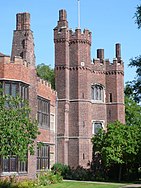History
Construction and royal visit by Richard III
The hall was built by Sir Thomas Burgh in 1460. The Burghs were rich, flamboyant and powerful. Gainsborough Old Hall was not only their home, but also a demonstration of their wealth and importance. Burgh was a benefactor to Newark Church and also the founder of the Chantry and Alms House at Gainsborough. In 1470, the manor was attacked by Sir Robert Welles over a clash about lands, status, and honour, but it was not severely damaged. In 1484 Thomas entertained King Richard III in his hall. [2] Henry VII intended to raise Thomas to the pre-eminence of a Barony, but no second writ was issued, nor was a patent.
Incarceration of Edward Burgh
In 1510, Thomas Burgh's son, Edward Burgh, 2nd Baron Burgh, was incarcerated at the Old Hall after being declared a lunatic, never having attended the House of Lords. He died in 1528, leaving his eldest son Sir Thomas as head of the family. He was regarded as 1st Baron Burgh, de jure 3rd.
Royal visits by Henry VIII and role in Catherine Howard's execution
Henry VIII visited Gainsborough twice: once in 1509, and again in 1541 with his fifth wife, Queen Katherine Howard. The Queen was accused of indiscretions both at Gainsborough and Lincoln, and she was later executed. Katherine Parr, by this time widowed twice (Edward Burgh having died in 1533), became Henry's sixth wife. [3]
Location of English Dissenters
When Thomas, the fifth Lord Burgh, died without an heir, the Hall was sold in 1596 to William Hickman, a merchant from London, who made many improvements, especially to the east wing. William and his mother Rose supported the Puritan Dissenters, and allowed John Smyth, Thomas Helwys and other excommunicated Puritans to worship and conduct services in the hall in early 17th century, until they sailed to the Netherlands in exile due to persecution and founded the Baptist tradition. The Hickman family continued to play a prominent role in the development of Gainsborough, and many became local members of Parliament. Sir Neville Hickman invited John Wesley to preach in the Great Hall several times in 1759, and in 1761 and 1764. [3] [4] [1]
Unoccupied building
In 1720 a new house was built at Thonock on the edge of the town and the Old Hall became unoccupied. It remained in the family and was used for a variety of purposes.
Architectural elements
Architecturally, the Old Hall has changed very little over the years. It is principally a timber framed building, giving a characteristic 'striped' or 'black and white' appearance. On the north-east corner is a brick tower. A splendid view of the town is available after a fifty-nine-step climb to the top.
Today, the Hall with its elaborate timber roof survives, with a kitchen which is possibly the most complete medieval kitchen in England. The kitchen still contains many original features, including two open fireplaces, each large enough to roast an ox, and two bread ovens served by a third chimney. [3]
Witches' marks
The Hall contains a great number of "witches' marks", thought to prevent against evil, and curses carved into its walls. There are also many burn marks, to protect against fire. [5]
This page is based on this
Wikipedia article Text is available under the
CC BY-SA 4.0 license; additional terms may apply.
Images, videos and audio are available under their respective licenses.





